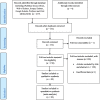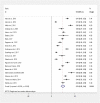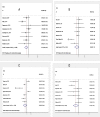Intestinal parasites among food handlers of food service establishments in Ethiopia: a systematic review and meta-analysis
- PMID: 31948421
- PMCID: PMC6966842
- DOI: 10.1186/s12889-020-8167-1
Intestinal parasites among food handlers of food service establishments in Ethiopia: a systematic review and meta-analysis
Abstract
Background: Intestinal parasites remain considerable public health problems in low-income countries where poor food hygiene practice is common. Food handlers, people involved in preparing and serving food, working with poor personal hygiene could pose a potential threat of spreading intestinal parasites to the public in a community. The aim of this systematic review and meta-analysis was, therefore, to synthesize the pooled prevalence estimate of intestinal parasites and associated pooled odds ratio of hygienic predictors among food handlers of food service establishments in Ethiopia that could aid to further bringing down the burden of intestinal parasites and it can also be used as a springboard for future studies.
Methods: We searched exhaustively for studies Published before 20 April 2019 using eight Databases; PubMed, Science Direct, Web of Science, Scopus, Embase, Google Scholar, ProQuest, and Ovid MEDLINE® complemented by the gray literature search. In the final synthesis, we included twenty study reports. We used the Cochrane Q test and I2 test to assess heterogeneity of studies, while we employed a funnel plot followed by Egger's regression asymmetry test and Begg rank correlation methods to evaluate publication bias. We also performed a point estimates and 95% confidence interval for each study using STATA version 14 statistical software.
Results: The overall pooled prevalence estimate of intestinal parasites among food handlers of food service establishments in Ethiopia was 33.6% (95%CI: 27.6-39.6%). Among ten intestinal parasites identified from food handlers, Entamoeba histolytica/ dispar (11, 95%CI: 7.9-14.1%) and Ascaris lumbricoides (8.8, 95%CI: 6.4-11.2%) were the most predominant intestinal parasites. Food handlers who washed hands after toilet use had 54% (OR, 0.46, 95% CI: 0.23-0.94) protection from intestinal parasites compared to those who did not.
Conclusions: This study revealed that intestinal parasitic infections are notable among food handlers of food service establishments in Ethiopia, which may be a risk for transmitting intestinal parasites to food and drinks consumers through the food chain. Thus, periodic stool checkup, training on intestinal parasitic infections and personal hygiene should be applied to reduce public health and socio-economic impacts of parasitic infections.
Keywords: Ethiopia; Food handlers; Intestinal parasites; Meta-analysis; Systematic review.
Conflict of interest statement
The authors declare that they have no competing interests.
Figures





Similar articles
-
Prevalence and Associated Risk Factors of Intestinal Parasites and Enteric Bacterial Infections among Selected Region Food Handlers of Ethiopia during 2014-2022: A Systematic Review and Meta-Analysis.ScientificWorldJournal. 2022 Oct 12;2022:7786036. doi: 10.1155/2022/7786036. eCollection 2022. ScientificWorldJournal. 2022. PMID: 36277127 Free PMC article.
-
Prevalence and factors associated with intestinal parasitic infections among food handlers working at higher public University student's cafeterias and public food establishments in Ethiopia: a systematic review and meta-analysis.BMC Infect Dis. 2020 Feb 19;20(1):156. doi: 10.1186/s12879-020-4884-4. BMC Infect Dis. 2020. PMID: 32075585 Free PMC article.
-
Prevalence of bacteria and intestinal parasites among food-handlers in Gondar town, northwest Ethiopia.J Health Popul Nutr. 2008 Dec;26(4):451-5. doi: 10.3329/jhpn.v26i4.1887. J Health Popul Nutr. 2008. PMID: 19069624 Free PMC article.
-
Burden and factors influencing intestinal parasitic infections among food handlers in Gondar City, Northwest Ethiopia.Front Public Health. 2024 Jun 11;12:1362086. doi: 10.3389/fpubh.2024.1362086. eCollection 2024. Front Public Health. 2024. PMID: 38919920 Free PMC article.
-
Prevalence of Intestinal Parasite Infections and Their Associated Factors among Food Handlers Working in Selected Catering Establishments from Bule Hora, Ethiopia.Biomed Res Int. 2021 Aug 19;2021:6669742. doi: 10.1155/2021/6669742. eCollection 2021. Biomed Res Int. 2021. PMID: 34458370 Free PMC article.
Cited by
-
The effect of compliance to Hand hygiene during COVID-19 on intestinal parasitic infection and intensity of soil transmitted helminthes, among patients attending general hospital, southern Ethiopia: Observational study.PLoS One. 2022 Jun 29;17(6):e0270378. doi: 10.1371/journal.pone.0270378. eCollection 2022. PLoS One. 2022. PMID: 35767582 Free PMC article.
-
Enteric Bacterial Infections, Antimicrobial Susceptibility Pattern, Intestinal Parasites, and Associated Factors Among Food Handlers in Yabelo Town, Borena Zone, Southern Ethiopia.Microbiol Insights. 2024 Jan 8;17:11786361231221717. doi: 10.1177/11786361231221717. eCollection 2024. Microbiol Insights. 2024. PMID: 38533273 Free PMC article.
-
Prevalence of Intestinal Parasitic Infections and Associated Factors Among Food Handlers in East Africa: A Systematic Review and Meta-analysis.Acta Parasitol. 2025 Jan 4;70(1):3. doi: 10.1007/s11686-024-00968-y. Acta Parasitol. 2025. PMID: 39755837
-
Prevalence of intestinal parasites in humans and domestic animals in Jirel community, Dolakha, Nepal.J Family Med Prim Care. 2024 Aug;13(8):3408-3414. doi: 10.4103/jfmpc.jfmpc_197_24. Epub 2024 Jul 26. J Family Med Prim Care. 2024. PMID: 39228571 Free PMC article.
-
Prevalence of intestinal parasites and associated factors among food handlers in food establishments in the Lideta subcity of Addis Ababa, Ethiopia: an institution-based, cross-sectional study.BMJ Open. 2022 Jul 20;12(7):e061688. doi: 10.1136/bmjopen-2022-061688. BMJ Open. 2022. PMID: 35858725 Free PMC article.
References
-
- Norhayati M, Fatmah M, Yusof S, Edariah A. Intestinal parasitic infections in man: a review. Med J Malays. 2003;58(2):296–305. - PubMed
-
- Ayeh-Kumi P, Quarcoo S, Kwakye-Nuako G, Kretchy J, Osafo-Kantanka A, Mortu S. Prevalence of intestinal parasitic infections among food vendors in Accra, Ghana. J Trop Med Parasitol. 2009;32(1):1–8.
Publication types
MeSH terms
LinkOut - more resources
Full Text Sources
Miscellaneous

